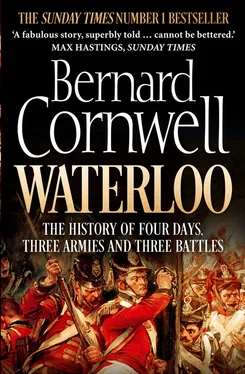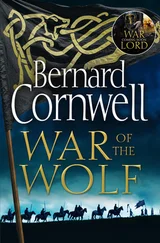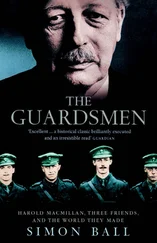Military history can be confusing. Roman numerals (IV Corps) march to meet Arabic numerals (3rd Div), and such labels tend to blur in the non-military mind. I have tried to avoid too much confusion, though perhaps I have added to it by using the words ‘battalion’ and ‘regiment’ to mean the same thing, when plainly they do not. The regiment was an administrative unit in the British army. Some regiments consisted of a single battalion, most had two battalions, and a few had three or even more. It was extremely rare for two British battalions of the same regiment to fight alongside each other in the same campaign, and at Waterloo only two regiments had that distinction. The 1st Regiment of Foot Guards had its 2nd and 3rd battalions at the battle, while the 95th Rifles had three battalions present. Every other battalion was the sole representative of its regiment, so if I refer to the 52nd Regiment I am meaning the 1st Battalion of that regiment. I sometimes use the term Guardsman for clarity, though in 1815 the privates of the British Guards were still referred to as ‘Private’.
All three armies at Waterloo were divided into Corps, thus both the British–Dutch army and the Prussian army were divided into three Corps. The French had four, because the Imperial Guard, though not referred to as a Corps, was effectively the same thing. A Corps could be anything from 10,000 to 30,000 men or more, and was intended to be an independent force, capable of deploying cavalry, infantry and artillery. In turn a Corps was divided into divisions, thus the French 1st Army Corps was divided into four infantry divisions, each between 4,000 and 5,000 strong, and one cavalry division with just over 1,000 men. Each division contained its own supporting artillery. A division might then be further split into brigades, thus the 2nd Infantry Division of the 1st Army Corps contained two brigades, one of seven battalions, the other of six. Battalions were split into companies; a French battalion had eight companies, a British had ten. The most common term in this book will be battalion (sometimes called a regiment). The largest British infantry battalion at Waterloo had over 1,000 men, but the average battalion, in all three armies, was around 500 men. So, in brief, the hierarchy was Army, Corps, Division, Brigade, Battalion, Company.
Some readers may be offended by the usage ‘English army’ when plainly the reference is to the British army. I have used the term ‘English army’ only where it occurs in original sources, choosing not to translate Anglais as British. There was no such thing as the English army, but in the early nineteenth century it was a term in common usage.
The battles of 16 June and 18 June 1815 make for a magnificent story. History is rarely kind to historical novelists by providing a neat plot with great characters who act within a defined time-period, so we are forced to manipulate history to make our own plots work. Yet when I wrote Sharpe’s Waterloo my plot almost entirely vanished to be taken over by the great story of the battle itself. Because it is a great story, not only in its combatants but in its shape. It is a cliffhanger. No matter how often I read accounts of that day, the ending is still full of suspense. The undefeated Imperial Guard climbs the ridge to where Wellington’s battered forces are almost at breaking point. Off to the east the Prussians are clawing at Napoleon’s right, but if the Guard can break Wellington’s men then Napoleon still has time to turn against Blücher’s arriving troops. It is almost the longest day of the year, there are two hours of daylight left and time enough for one or even two armies to be destroyed. We might know how it ends, but like all good stories it bears repetition.
So here it is again, the story of a battle.
PREFACE CONTENTS Cover Title Page Copyright Dedication TO WILL AND ANNE CLEVELAND Foreword Preface 1 Glorious news! Nap’s landed again in France, Hurrah! 2 Napoleon has humbugged me, by God! 3 The fate of France is in your hands! 4 Avancez, mes enfants, courage, encore une fois, Français! 5 Ah! Now I’ve got them, those English! 6 A cannon ball came from the Lord knows where and took the head off our right-hand man 7 The Big Boots don’t like rough stuff! 8 Those terrible grey horses, how they fight! 9 We had our revenge! Such slaughtering! 10 The most beautiful troops in the world 11 Defend yourselves! Defend yourselves! They are coming in everywhere! 12 Next to a battle lost, the greatest misery is a battle gained Aftermath: A thousand shall fall beside thee, and ten thousand at thy right hand, but it shall not come nigh thee Afterword Bibliography Index Acknowledgements Picture Credits About the Publisher ‘The Field of Waterloo, from the Picton Tree’, by J. M. W. Turner, circa 1833. The painting severely exaggerates the steepness of the valley’s slopes, but does convey the small size of the battlefield.

IN THE SUMMER OF 1814 His Grace the Duke of Wellington was on his way from London to Paris to take up his appointment as British ambassador to the new regime of Louis XVIII. He might have been expected to take the short route from Dover to Calais, but instead a Royal Navy brig, HMS Griffon , carried him across the North Sea to Bergen-op-Zoom. He was visiting the newly created Kingdom of the Netherlands, an awkward invention, half French, half Dutch, half Catholic and half Protestant, which lay to the north of France. British troops had been posted in the new nation as guarantors of its existence, and the Duke had been asked to inspect the defences along the French border. He was accompanied by ‘Slender Billy’, also known as the ‘Young Frog’, the 23-year-old Prince William, who was Crown Prince of the new kingdom and who, because he had served on the Duke’s staff in the Peninsular War, believed himself to possess military talent. The Duke spent a fortnight touring the borderlands and suggested restoring the fortifications of a handful of towns, but it is hard to believe he took the prospect of a renewed French war too seriously.
Napoleon, after all, was defeated and had been exiled to the Mediterranean island of Elba. France was a monarchy again. The wars were over, and in Vienna the diplomats were forging the treaty that would remake the boundaries of Europe to ensure that another war did not ravage the continent.
And Europe had been ravaged. Napoleon’s abdication had ended twenty-one years of warfare that had begun in the wake of the French Revolution. The old regimes of Europe, the monarchies, had been horrified by the events in France and shocked by the executions of Louis XVI and his queen, Marie Antoinette. Fearing that the ideas of the Revolution would spread to their own countries, they had gone to war.
They had expected a swift victory over the ragged armies of Revolutionary France, but instead they sparked a world war which saw both Washington and Moscow burned. There had been fighting in India, Palestine, the West Indies, Egypt and South America, but Europe had suffered the worst. France had survived the initial onslaught, and from the chaos of revolution there emerged a genius, a warlord, an Emperor. Napoleon’s armies had shattered the Prussians, the Austrians and the Russians, they had marched from the Baltic to the southern shores of Spain, and the Emperor’s feckless brothers had been placed on half the thrones of Europe. Millions had died, but after two decades it was all over. The warlord was caged.
Napoleon had dominated Europe, but there was one enemy he had never met and whom he had never defeated, and that was the Duke of Wellington, whose military reputation was second only to Napoleon’s. He had been born Arthur Wesley, the fourth son of the Earl and Countess of Mornington. The Wesley family were part of the Anglo-Irish aristocracy and Arthur spent most of his youth in Ireland, the country of his birth, though most of his education was at Eton, where he was not happy. His mother, Anne, despaired of him. ‘I don’t know what I shall do with my awkward son Arthur,’ she complained, but the answer, as for so many younger sons of the nobility, was to arrange a commission in the army. And so began an extraordinary career as the awkward Arthur discovered a talent for soldiering. The army recognized that talent and rewarded it. He first commanded an army in India, where he won a series of astonishing victories, then he was recalled to Britain and entrusted with the small expeditionary army that was trying to keep the French from occupying Portugal. That small army had grown into the mighty force that liberated Portugal and Spain and invaded southern France. It had won victory after victory. Arthur Wellesley (the family had changed the surname from Wesley) had become the Duke of Wellington and was recognized as one of the two greatest soldiers of the age. Alexander I, the Czar of Russia, was to call him ‘ Le vainqueur du vainqueur du monde ’, the conqueror of the world’s conqueror, and the world’s conqueror was, of course, Napoleon. And in twenty-one years of war the Duke and the Emperor had never fought each other.
Читать дальше













